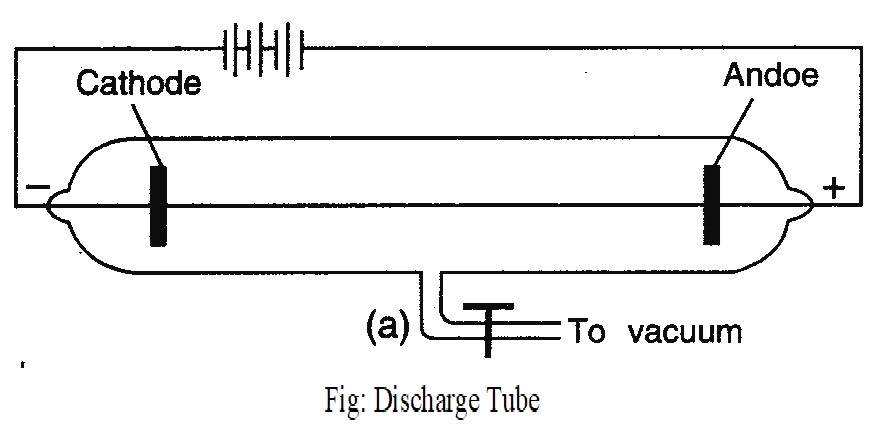Discovery of Electron:
The first of the subatomic particles to be discovered was the Electron (e). The knowledge about the electron was derived as a result of the study of the electric discharge in the discharge tube (J.J. Thomson, 1896). The discharge tube consists of a glass tube with metal electrodes fused in the walls. Through a glass side-arm air can be drawn with a pump. The electrodes are connected to a source of high voltage (10,000 Volts) and the air partially evacuated. The electric discharge passes between the electrodes and the residual gas in the tube begins to glow. If virtually all the gas is evacuated from within the tube, the glow is faintly replaced by faintly luminous ‘rays’ which produce fluorescence on the glass at the end far from the cathode. The rays which proceed from the cathode and move away from it at right angles in straight lines, are called Cathode Rays

Properties of Cathode Rays:
Cathode rays are found to possess the following properties:
- They travel in straight lines away from the cathode and cast shadows of metallic objects placed in their path.
- Cathode rays cause mechanical motion of a small pin-wheel placed in their path. Thus they possess kinetic energy and must be material particles.
- They produce fluorescence (a glow) when they strike the glass wall of the discharge tube.
- They heat up a metal foil to incondescence which they impinge upon.
- Cathode rays produce X-rays when they strike a metallic target.
- Cathode rays are deflected by the electric as well as the magnetic field in a way indicating that they are streams of minute particles carrying negative charge
Mass of Electrons:
By using the Thomson’s value of e/m and the Millikan’s value of e, the absolute mass of an electron can be found.
e/m = 1.76 X 108 C/g (Thomson)
e = 1.60 X 10-19 C (Milikan)
Therefore, e/e/m = 1.60 X 10-19 C/1.76 X 108 C/g = 9.11 X 10-24 g.
“An electron may be defined as a subatomic particles which bears one unit negative charge (-1.60 X 10-19 C) and has mass 9.11 X 10-24 g”.